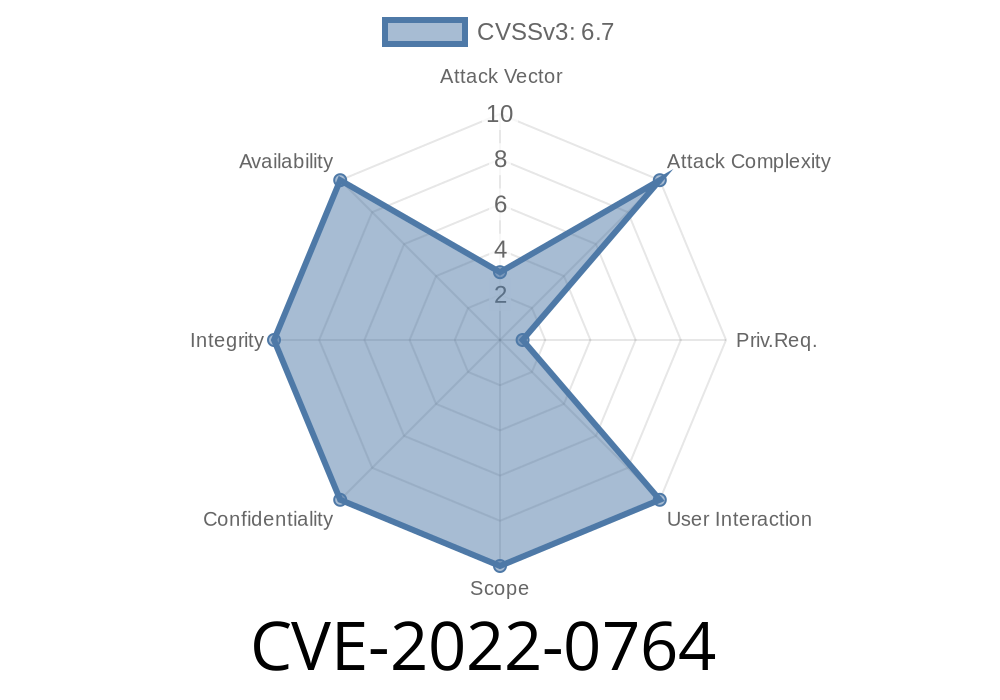The open-source headless content management system (CMS) Strapi has recently come under the spotlight due to a critical vulnerability identified in its codebase. The vulnerability, titled CVE-2022-0764, affects all Strapi instances prior to version 4.1. and allows an attacker to execute arbitrary commands on the server hosting the vulnerable application. This vulnerability has the potential to be extremely destructive, as it provides the attacker with an opportunity to take complete control of the server.
Affected Software
GitHub Repository: strapi/strapi
Versions: Up to and including 4..
Details of the Vulnerability
CVE-2022-0764 is an arbitrary command injection vulnerability that was present in Strapi's core codebase until the recent release of version 4.1.. The vulnerability exists in a specific code snippet that does not properly sanitize user-supplied input, leading to the possibility for an attacker to inject arbitrary commands into the system.
Here's a snippet of the vulnerable code from the Strapi codebase
function executeCommand(command, callback) {
// Here be dragons
const commandToExecute = sh -c "${command}";
return exec(commandToExecute, (error, stdout, stderr) => {
if (error) {
console.error(exec error: ${error});
return;
}
console.log(stdout: ${stdout});
console.error(stderr: ${stderr});
callback(stdout);
});
}
In the code snippet above, the executeCommand() function takes the user-supplied input command and executes it without proper sanitization, leading to a command injection vulnerability.
Exploit Details
To exploit this vulnerability, an attacker would simply need to craft a malicious request containing the command they want to execute. For example, an attacker could send the following payload to the vulnerable Strapi instance:
curl -X POST http://<target-url>/api/exec-cmd -H "Content-Type: application/json" -d '{"command": "touch /tmp/exploit; echo CVE-2022-0764;"}'
In this example, the payload would create a new file named /tmp/exploit and print "CVE-2022-0764" on the target system, demonstrating command injection. In a real-world attack scenario, much more nefarious payloads could be used to exfiltrate data, escalate privileges, or fully compromise the server.
Original References
1. Strapi GitHub Repository: https://github.com/strapi/strapi
2. Strapi Release Notes (v4.1.): https://github.com/strapi/strapi/releases/tag/v4.1.
3. CVE-2022-0764 Details: https://cve.mitre.org/cgi-bin/cvename.cgi?name=CVE-2022-0764
Mitigation and Recommendations
To mitigate this vulnerability, users running a vulnerable version of Strapi are advised to upgrade to version 4.1. or later. The release notes for Strapi v4.1. include a mention of the vulnerability, emphasizing its importance for users to update their Strapi instances immediately. You can find information on how to upgrade your Strapi instance in the official Strapi documentation:
- Strapi Migration Guide: https://docs.strapi.io/developer-docs/latest/update-migration-guides/migration-guides.html
Additionally, it is recommended to implement proper input validation and sanitization practices when handling user-supplied data to prevent similar vulnerabilities from occurring in the future.
Conclusion
This post aimed to provide a detailed overview of the CVE-2022-0764 vulnerability, which affects all Strapi instances prior to version 4.1.. The exploit details and snippets of the vulnerable code show how simple it is for an attacker with knowledge of this vulnerability to execute arbitrary commands on the target system. Strapi's developers have taken steps to address this vulnerability by releasing version 4.1., and users of the CMS should act promptly to safeguard their applications from potential attacks.
Timeline
Published on: 02/26/2022 15:15:00 UTC
Last modified on: 07/22/2022 10:28:00 UTC
